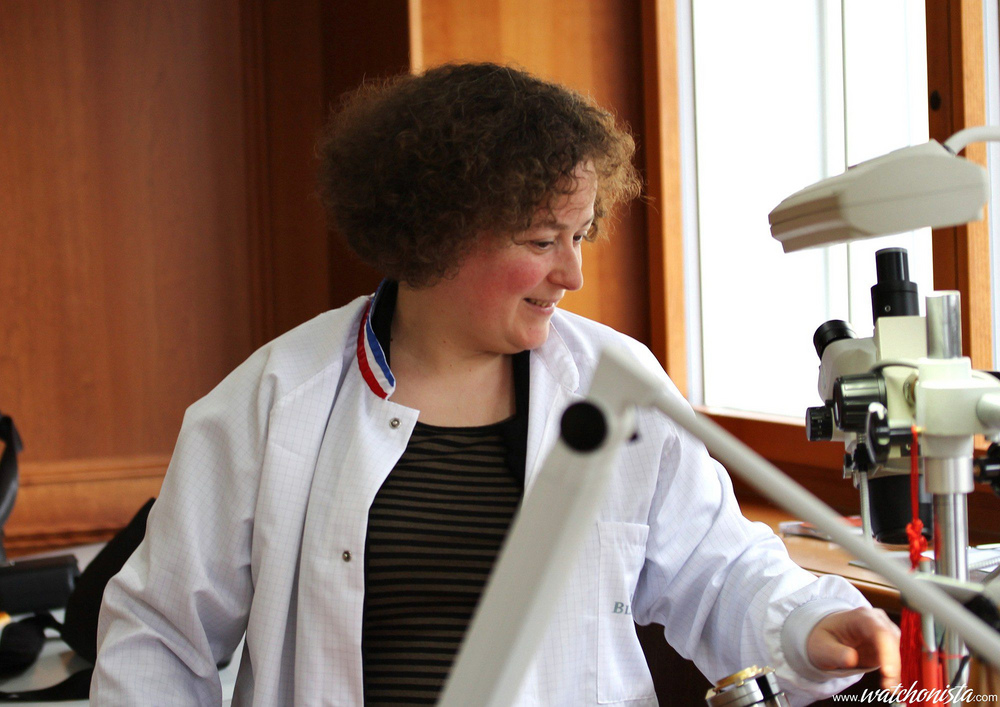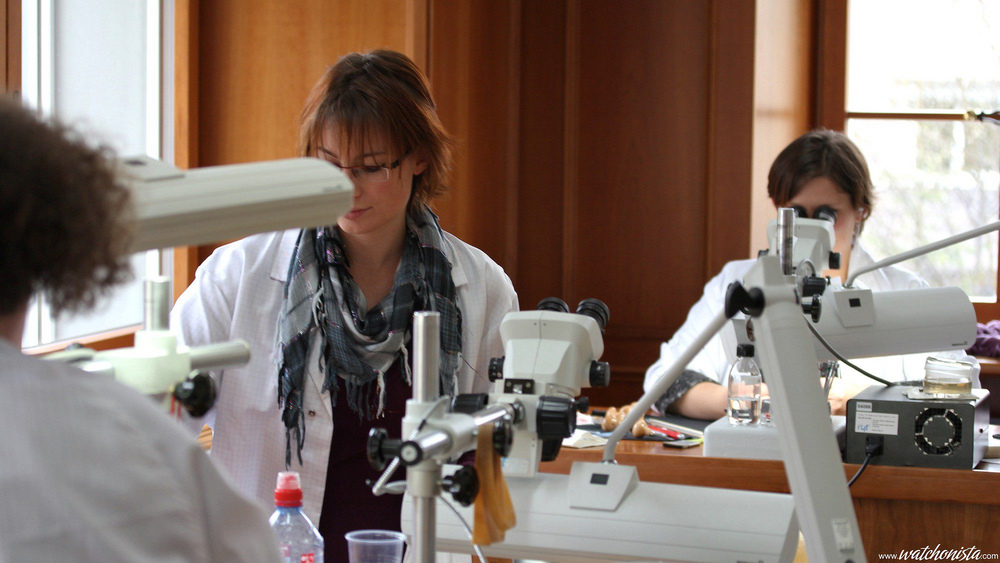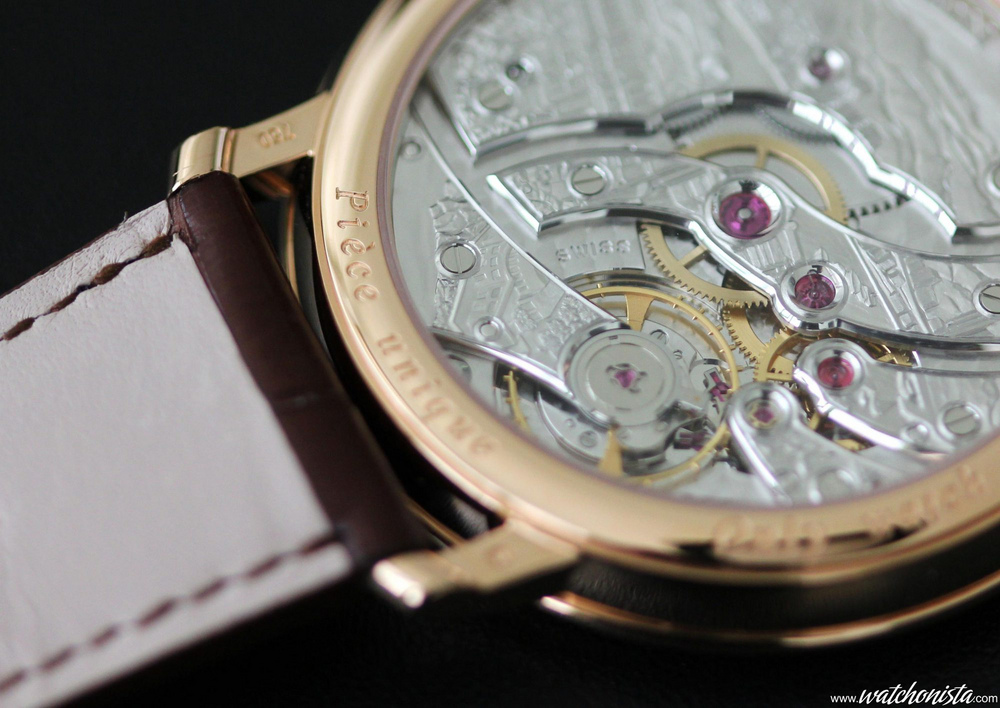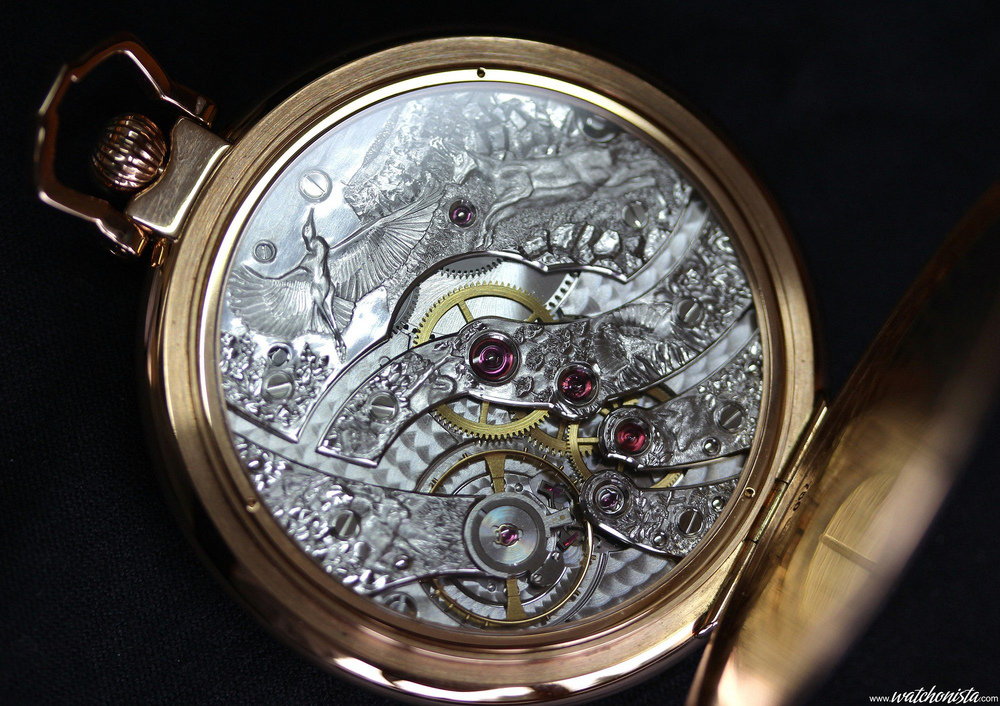Maybe you remember the article on the Blancpain Villeret Grande Decoration for Only Watch, published about one year ago...
Under its apparent simplicity, this watch's caseback is abundantly decorated. Indeed, the front face features a superb Grand Feu enamel dial; it takes a trained eye to appreciate the subtle work executed on the painted numerals, with their "hollowed body". On the contrary, the back side is a festival; the bridges feature a superb handmade engraving of the "Rocher de Monaco". This work has been executed by Marie-Laure Tabouriech, a "Best craftsman of France".

To well understand the added value of a handmade engraving on a caliber or a watchcase, one has to look into the history of engraving...
Engraving, together with painting and music, is one of the prime arts in the history of humanity. This art is born when the human kind realizes that he can leave a permanent mark on his environment. It is indisputable that prehistoric carving (directly on stone or on bark) somehow led humanity to understand its role in the modification of the environment, which is nowadays a hot topic, with the environmental crisis we are experiencing....
Etching, a more recent medium, was for a long time the way through which journalism allowed our ancestors to discover the beauties from beyond the oceans.
Of course, the art of engraving developed in parallel with the art of painting; for that matter, a large part of the great painters, from Da Vinci to Picasso, also created superb engravings. Indeed, both art mediums rise from the same creative process. When one extrapolates this shared history to the watch dials, one could picture engraving as the tridimensional equivalent of enameling. Besides, the two techniques are sometimes mixed, as it is the case for the Champlevé enamel, which relies on both crafts.
However, engraving is more adapted to the movements' decoration for an obvious technical reason:
The dust produced during the enameling process could indeed jeopardize the caliber's accuracy.

Handmade engraving, with its typical human lack of precision, gives rise to a fundamental question: what is the value of a watch?
Is it the absolute informatics precision, reached through a multitude of CNC and chemical treatments, or is it the tireless manual work furnished by a troop of excellent craftsmen?

If one considers the fact that ultra-precise handmade finishes by someone like Philippe Dufour are, for many dandies, the ultimate Holy Grail of watchmaking, one could conclude, at least with respect to the decorations, that what makes the "Swissness" more than perfect, is the number of hours spent to decorate a watch.
Therefore, someone will dedicate lots of time and energy to decorate your Blancpain, and this person is Marie-Laure Tabouriech. In the Tabouriech family, the decoration craft is a tradition: Marie-Laure's father and grandfather were also engravers; she inherited her family's fairy-fingers. After 10 years spent in the perfume industry (the delicate vial prototypes were done under her direction), she had the opportunity to integrate Blancpain.
Crafting the ultimate decorations by hand is fine. Publicize it is better. When Blancpain understood Marie-Laure's potentiality, the company granted her three months to prepare the "Best craftsman of France" contest.
It is a prestigious competition, organized since 1929. An avatar of companionship, its goal is to create the emulation between the best craftsmen.
Thanks to this type of event, which promotes the know-how and the very high quality, France has been able to develop a prestigious industry of luxury, envied worldwide.

Marie-Laure got a free-hand to take up the challenge. She chose rather classic themes, in the same vein as her current work (but not necessarily as her next ).
).
As a matter of fact, she chose to reproduce a drawing by Leonardo Da Vinci: a fantastic warrior's profile. Regarding the horologic part, it was a Blancpain pocket watch, fitted with a 151B caliber.

Reproducing Da Vinci's knight is a double feat: It has been engraved on a steel sheet (as a template, for the embossing process), a relatively hard alloy, difficult to carve, which lengthen the work time... But above all, the carving had to be less than half a millimeter deep. The relief and the depth are reached through optical effects. Marie-Laure created a perfect illusion, with her master chisel stroke.

The pocket watch is in the same vein as Marie-Laure's actual work. It is equipped with a caliber formerly named "Piguet 151" of 16 lines, since the integration of the Frederic Piguet house within Blancpain it is always the 151 but B. The bridges are made of brass; since it is a far more ductile alloy than steel, it is easier to work. Surely, carving is easier on brass, but with a watch movement, it gets more difficult in totally different ways.
First of all, the 151B is not a Lange movement with a ¾ plate; here, the plate is cut out with bridges very far apart.
As a consequence, it is far more difficult to get an overall visual coherence. Moreover, the engraving is hardly deeper than the classic côtes de Genève; nonetheless, Marie-Laure Tabouriech must preserve enough contrast to make the scene lively. In fact, it is like shooting a short film, intended for a cell phone screen and watched in a subway train. It takes a hell of a time to keep the image coherent.

This caliber referenced 151B or 15B (for the "wrist" version), with its wide bridges, is the primary mechanism engraved by the team of Marie-Laure. The Villeret Grand Decoration and Villeret Pocket Watch are customizable to satiety.
You just have to go to a Blancpain shop, make a deposit and you ask your own personal movement. This is one of the most advanced customization options in the watch industry, with a caliber entirely decorated according to your wishes.
Prior to the conclusion, let's play a little game:
The ornament pictures a typical valley of the Jura, together with its fauna.
One can see a heron, a chamois, a fox, a capercaillie, a weasel, a squirrel, two birds, an oriole and a bobcat; but also with its flora: absinthe, huckleberry, daffodil, gentian...
I will let you find these animals on the Blancpain, the answers in a few days.

In 2012, we live in a world of automation, of absolute standardization; a world where the robot's productivity is so effective that kids are losing their jobs in factories of developing nations!
On the contrary, luxury is more than ever the unique work of highly skilled craftsmen. That is why Marie-Laure Tabouriech's work is important.

Under its apparent simplicity, this watch's caseback is abundantly decorated. Indeed, the front face features a superb Grand Feu enamel dial; it takes a trained eye to appreciate the subtle work executed on the painted numerals, with their "hollowed body". On the contrary, the back side is a festival; the bridges feature a superb handmade engraving of the "Rocher de Monaco". This work has been executed by Marie-Laure Tabouriech, a "Best craftsman of France".

To well understand the added value of a handmade engraving on a caliber or a watchcase, one has to look into the history of engraving...
Engraving, together with painting and music, is one of the prime arts in the history of humanity. This art is born when the human kind realizes that he can leave a permanent mark on his environment. It is indisputable that prehistoric carving (directly on stone or on bark) somehow led humanity to understand its role in the modification of the environment, which is nowadays a hot topic, with the environmental crisis we are experiencing....
Etching, a more recent medium, was for a long time the way through which journalism allowed our ancestors to discover the beauties from beyond the oceans.
Of course, the art of engraving developed in parallel with the art of painting; for that matter, a large part of the great painters, from Da Vinci to Picasso, also created superb engravings. Indeed, both art mediums rise from the same creative process. When one extrapolates this shared history to the watch dials, one could picture engraving as the tridimensional equivalent of enameling. Besides, the two techniques are sometimes mixed, as it is the case for the Champlevé enamel, which relies on both crafts.
However, engraving is more adapted to the movements' decoration for an obvious technical reason:
The dust produced during the enameling process could indeed jeopardize the caliber's accuracy.

Handmade engraving, with its typical human lack of precision, gives rise to a fundamental question: what is the value of a watch?
Is it the absolute informatics precision, reached through a multitude of CNC and chemical treatments, or is it the tireless manual work furnished by a troop of excellent craftsmen?

If one considers the fact that ultra-precise handmade finishes by someone like Philippe Dufour are, for many dandies, the ultimate Holy Grail of watchmaking, one could conclude, at least with respect to the decorations, that what makes the "Swissness" more than perfect, is the number of hours spent to decorate a watch.
Therefore, someone will dedicate lots of time and energy to decorate your Blancpain, and this person is Marie-Laure Tabouriech. In the Tabouriech family, the decoration craft is a tradition: Marie-Laure's father and grandfather were also engravers; she inherited her family's fairy-fingers. After 10 years spent in the perfume industry (the delicate vial prototypes were done under her direction), she had the opportunity to integrate Blancpain.
Crafting the ultimate decorations by hand is fine. Publicize it is better. When Blancpain understood Marie-Laure's potentiality, the company granted her three months to prepare the "Best craftsman of France" contest.
It is a prestigious competition, organized since 1929. An avatar of companionship, its goal is to create the emulation between the best craftsmen.
Thanks to this type of event, which promotes the know-how and the very high quality, France has been able to develop a prestigious industry of luxury, envied worldwide.

Marie-Laure got a free-hand to take up the challenge. She chose rather classic themes, in the same vein as her current work (but not necessarily as her next
 ).
).As a matter of fact, she chose to reproduce a drawing by Leonardo Da Vinci: a fantastic warrior's profile. Regarding the horologic part, it was a Blancpain pocket watch, fitted with a 151B caliber.

Reproducing Da Vinci's knight is a double feat: It has been engraved on a steel sheet (as a template, for the embossing process), a relatively hard alloy, difficult to carve, which lengthen the work time... But above all, the carving had to be less than half a millimeter deep. The relief and the depth are reached through optical effects. Marie-Laure created a perfect illusion, with her master chisel stroke.

The pocket watch is in the same vein as Marie-Laure's actual work. It is equipped with a caliber formerly named "Piguet 151" of 16 lines, since the integration of the Frederic Piguet house within Blancpain it is always the 151 but B. The bridges are made of brass; since it is a far more ductile alloy than steel, it is easier to work. Surely, carving is easier on brass, but with a watch movement, it gets more difficult in totally different ways.
First of all, the 151B is not a Lange movement with a ¾ plate; here, the plate is cut out with bridges very far apart.
As a consequence, it is far more difficult to get an overall visual coherence. Moreover, the engraving is hardly deeper than the classic côtes de Genève; nonetheless, Marie-Laure Tabouriech must preserve enough contrast to make the scene lively. In fact, it is like shooting a short film, intended for a cell phone screen and watched in a subway train. It takes a hell of a time to keep the image coherent.

This caliber referenced 151B or 15B (for the "wrist" version), with its wide bridges, is the primary mechanism engraved by the team of Marie-Laure. The Villeret Grand Decoration and Villeret Pocket Watch are customizable to satiety.
You just have to go to a Blancpain shop, make a deposit and you ask your own personal movement. This is one of the most advanced customization options in the watch industry, with a caliber entirely decorated according to your wishes.
Prior to the conclusion, let's play a little game:
The ornament pictures a typical valley of the Jura, together with its fauna.
One can see a heron, a chamois, a fox, a capercaillie, a weasel, a squirrel, two birds, an oriole and a bobcat; but also with its flora: absinthe, huckleberry, daffodil, gentian...
I will let you find these animals on the Blancpain, the answers in a few days.

In 2012, we live in a world of automation, of absolute standardization; a world where the robot's productivity is so effective that kids are losing their jobs in factories of developing nations!
On the contrary, luxury is more than ever the unique work of highly skilled craftsmen. That is why Marie-Laure Tabouriech's work is important.

